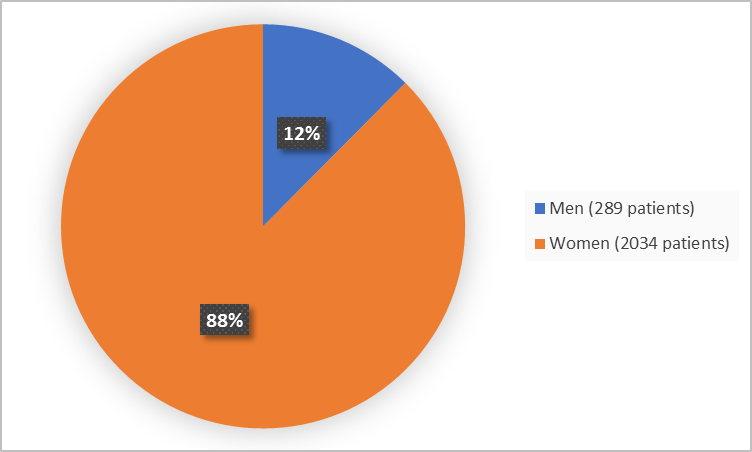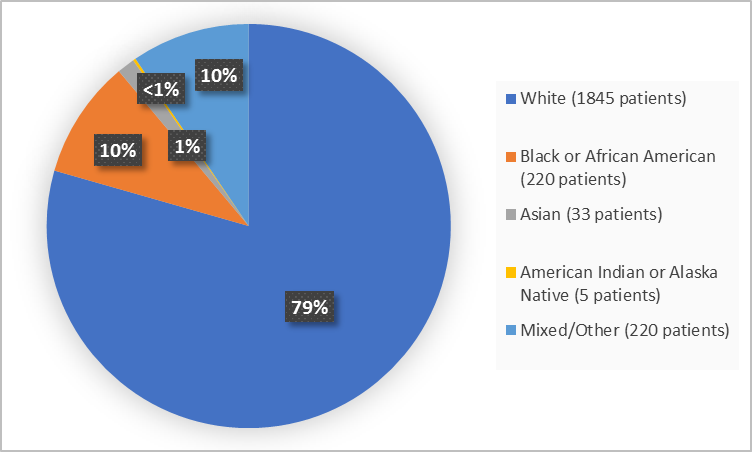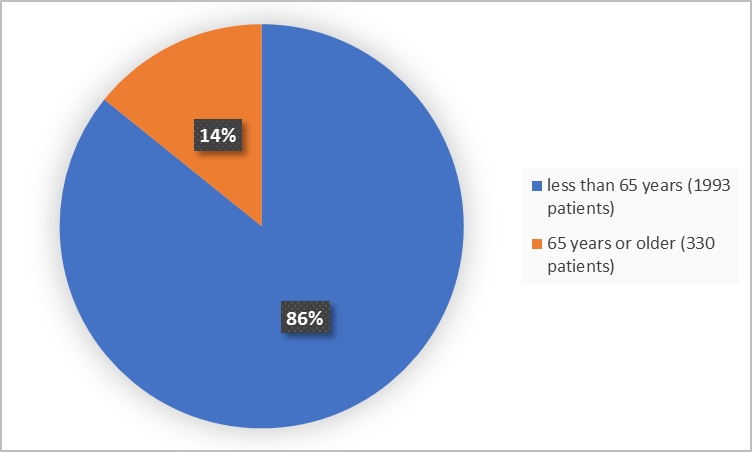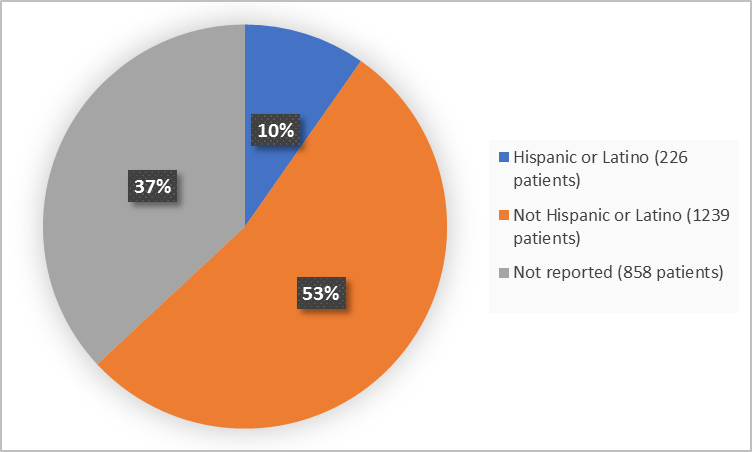Drug Trials Snapshots: BARHEMSYS
HOW TO USE THIS SNAPSHOT
The information provided in Snapshots highlights who participated in the clinical trials that supported the FDA approval of this drug, and whether there were differences among sex, race and age groups. The “MORE INFO” bar shows more detailed, technical content for each section. The Snapshot is intended as one tool for consumers to use when discussing the risks and benefits of the drugs.
LIMITATIONS OF THIS SNAPSHOT:
Do not rely on Snapshots to make decisions regarding medical care. Always speak to your health provider about the risks and benefits of a drug. Refer to the BARHEMSYS Prescribing Information for complete information.
BARHEMSYS (amisulpride)
bah - rem’ - sis
Acacia Pharma.
Approval date: February 26, 2020
DRUG TRIALS SNAPSHOT SUMMARY:
What is the drug for?
BARHEMSYS is a drug used in adults to prevent or treat postoperative nausea and vomiting (PONV). It is to be used:
- for prevention of PONV either alone, or together with a different drug for PONV prevention
- for treatment of PONV in patients who have not received any drug for the prevention of PONV, or those who have received a different drug for the prevention for PONV
How is this drug used?
BARHEMSYS is an injection given directly into the vein (intravenous infusion) by a healthcare professional over 1-2 minutes
What are the benefits of this drug?
Patients taking BARHEMSYS experienced less nausea/vomiting and less need for additional medication to prevent or treat PONV in comparison to patients receiving placebo.
What are the benefits of this drug (results of trials used to assess efficacy)?
The efficacy results of BARHEMSYS for the prevention of PONV are presented in Table 2.
The primary efficacy endpoint was Complete Response (CR), defined as absence of any episode of vomiting or use of rescue medication within the first 24 hours postoperatively.
Table 1. Complete Response Rates in Adult Patients for the Prevention of PONV Within 24 Hours After End of Surgery in Trials 1 and 2
| Trial 1 | Trial 2 | |||
|---|---|---|---|---|
| BARHEMSYS 5 mg (n=176) |
Placebo (n=166) |
BARHEMSYS 5 mg with Another Antiemetic (n=572) |
Placebo with Another Antiemetic (n=575) |
|
| Complete Response | 78 (44%) | 54 (33%) | 330 (58%) | 268 (47%) |
| Difference (95% CI)* |
12% (2%, 22%) |
11% (5%, 17%) |
||
*Unadjusted, nominal 95% confidence interval
The efficacy results of BARHEMSYS for the treatment of PONV are presented in Table 3.
The primary efficacy endpoint was Complete Response (CR) defined as absence of any episode of vomiting or use of rescue medication within the first 24 hours after treatment (excluding vomiting within the first 30 minutes).
Table 2. Complete Response Rates in Adult Patients for the Treatment of PONV Within 24 hours After Treatmenta in Trials 3 and 4
| Trial 3 (no prophylaxis) |
Trial 4 (prior prophylaxis)b |
|||
|---|---|---|---|---|
| BARHEMSYS 10 mg (n=188) |
Placebo (n=181) |
BARHEMSYS 10 mg (n=230) |
Placebo (n=235) |
|
| Complete Response | 59 (31%) | 39 (22%) | 96 (42%) | 67 (29%) |
| Difference (95% CI)c | 10% (1%, 19%) | 13% (5%, 22%) | ||
aExcluding emesis within the first 30 minutes
bReceived prior PONV prophylaxis with one or more non-dopaminergic antiemetics: a 5 HT3-antagonist in 77%, dexamethasone in 65% and another antiemetic class in 10%
c Unadjusted, nominal 95% confidence interval
Were there any differences in how well the drug worked in clinical trials among sex, race, and age?
Subgroup analyses were conducted for sex, race, and age.
- Sex: BARHEMSYS worked similarly in men and women.
- Race: The majority of patients were White; therefore, differences in how the drug worked among races could not be determined.
- Age: BARHEMSYS worked similarly in patients younger than 65 years and patients 65 years and older.
Were there any differences in how well the drug worked in clinical trials among sex, race, and age groups?
The tables below summarize efficacy results by subgroups.
Table 3. Complete Response Rates by Sex
| Prevention Trials | BARHEMSYS 5 mg n/N (%) |
Placebo n/N (%) |
|---|---|---|
| Trial 1 | ||
| Men | 36/62 (58.1) | 27/56 (48.2) |
| Women | 42/114 (36.8) | 27/110 (24.6) |
| Trial 2 | ||
| Men | 11/20 (55) | 12/18 (66.7) |
| Women | 319/552 (57.8) | 256/557 (46) |
| Treatment Trials | BARHEMSYS 10 mg n/N (%) |
Placebo n/N (%) |
| Trial 3 | ||
| Men | 14/43 (32.6) | 13/45 (28.9) |
| Women | 45/145 (31) | 26/136 (19.1) |
| Trial 4 | ||
| Men | 12/22 (54.6) | 6/23 (26.1) |
| Women | 84/208 (40.4) | 61/212 (28.8) |
Table 4. Complete Response Rates by Race
| Prevention Trials | BARHEMSYS 5 mg< n/N (%) |
Placebo< n/N (%) |
|---|---|---|
| Trial 1 | ||
| White | 71/157 (45.2) | 47/140 (33.6) |
| All Other | 7/19 (36.8) | 7/26 (26.9) |
| Trial 2 | ||
| White | 242/438 (55.3) | 189/425 (44.5) |
| All Other | 21/55 (38.2) | 31/65 (47.7) |
| Treatment Trials | BARHEMSYS 10 mg< n/N (%) |
Placebo< n/N (%) |
| Trial 3 | ||
| White | 45/152 (29.6) | 34/151 (22.5) |
| All Other | 8/21 (38.1) | 3/16 (18.8) |
| Trial 4 | ||
| White | 80/189 (42.3) | 54/193 (28) |
| All Other | 11/27 (40.7) | 8/30 (26.7) |
Table 5. Complete Response Rates by Age
| Prevention Trials | BARHEMSYS 5 mg n/N (%) |
Placebo n/N (%) |
|---|---|---|
| Trial 1 | ||
| <65 years | 47/123 (38.2) | 42/132 (31.8) |
| ≥65 years | 31/53 (58.5) | 12/34 (35.3) |
| Trial 2 | ||
| <65 years | 262/487 (53.8) | 223/501 (44.5) |
| ≥65 y | 68/85 (80) | 45/74 (60.8) |
| Treatment Trials | BARHEMSYS 10 mg n/N (%) |
Placebo n/N (%) |
| Trial 3 | ||
| <65 years | 53/168 (31.5) | 33/159 (20.8) |
| ≥65 years | 6/20 (30) | 6/22 (27.3) |
| Trial 4 | ||
| <65 years | 83/206 (40.3) | 65/217 (30) |
| ≥65 years | 13/24 (54.2) | 2/18 (11.1) |
Clinical Trial Data
What are the possible side effects?
BARHEMSYS may cause serious heart rhythm problems due to prolongation of heart electrical activity (QT prolongation).
The most common side effects of BARHEMSYS are increased level of prolactin hormone in blood, chills, low serum potassium level, low blood pressure during infusion, and abdominal distension and infusion site pain.
What are the possible side effects (results of trials used to assess safety)?
Presented below are adverse reactions observed in the trials for prevention and treatment of PONV, respectivly.
Table 6. Common Adverse Reactions* in Adult Patients in Trials 1 and 2 of BARHEMSYS for Prevention of PONV
| BARHEMSYS 5 mg | Placebo | |
|---|---|---|
| N=748 | N=741 | |
| Chills | 4% | 3% |
| Hypokalemia | 4% | 2% |
| Procedural hypotension | 3% | 2% |
| Abdominal distension | 2% | 1% |
*reported in at least 2% of patients treated with BARHEMSYS and at a higher rate than placebo
Treatment of PONV
The most common adverse reaction, reported in at least 2% of adult patients who received BARHEMSYS 10 mg (N=418) and at a higher rate than placebo (N=416), in clinical trials for the treatment of PONV (Trials 3 and 4) was infusion site pain (BARHEMSYS 6%; placebo 4%).
BARHEMSYS Prescribing Information
Were there any differences in side effects among sex, race, and age?
- Sex: The occurrence of side effects was similar in men and women.
- Race: The majority of patients were White. Therefore, differences in side effects among races could not be determined.
- Age: The occurrence of side effects was similar in patients below 65 years of age and those 65 years and above.
Were there any differences in side effects of the clinical trials among sex, race, and age groups?
The table below summarizes sex and age subgroups of patients who reported any treatment emergent adverse event (TEAE) during clinical trial.
Table 7. Subgroup Analyses of TEAEs by Sex
| BARHEMSYS 5 mg |
BARHEMSYS 5 mg + antiemetic |
BARHEMSYS 10 mg | Placebo | Placebo + antiemetic |
||||||
|---|---|---|---|---|---|---|---|---|---|---|
| Men N=155 |
Women N=668 | Men N=20 |
Women N=552 |
Men N=65 |
Women N=335 |
Men N=155 |
Women N=659 |
Men N=18 | Women N=557 | |
| Any TEAE | 47% | 58% | 20% | 42% | 29% | 45% | 54% | 63% | 22% | 50% |
Table 8. Subgroup Analyses of TEAEs by Age
| BARHEMSYS 5 mg | BARHEMSYS 5 mg + antiemetic |
BARHEMSYS 10 mg | Placebo | Placebo + antiemetic |
||||||
|---|---|---|---|---|---|---|---|---|---|---|
| <65 y N=682 |
≥ 65 y N=141 |
<65 y N=487 |
≥ 65 y N=85 |
<65 y N=374 |
≥ 65 y N=44 |
<65 y N=696 |
≥ 65 y N=118 |
<65 y N=501 |
≥ 65 y N=74 |
|
| Any TEAE | 54% | 65% | 40% | 47% | 41% | 55% | 60% | 65% | 47% | 60% |
Clinical Trial Data
WHO WAS IN THE CLINICAL TRIALS?
Who participated in the clinical trials?
The FDA approved BARHEMSYS based on evidence from 4 clinical trials of 2323 patients undergoing surgery or experiencing nausea and vomiting after the surgery. The trials were conducted at 80 sites in the United States, Canada and Europe.
The figure below summarizes how many men and women were in the clinical trials.
Figure 1. Demographics by Sex
Clinical Trial Data
The figure and table below summarize the percentage of patients by race in the clinical trials.
Figure 2. Demographics by Race
Clinical Trial Data
The figure below sumarizes the percentage of patients by age in the clinical trials.
Figure 3. Demographics by Age
Clinical Trial Data
The figure below sumarizes the percentage of patients by ethnicity in the clinical trials.
Figure 4. Demographics by Ethnicity
Clinical Trial Data
Who participated in the trials?
The table below summarizes demographic characteristics of patients participating in the four trials.
Table 9. Demographics in Combined Trials 1-4
| Demographic Characteristic | Trials 1 and 2 N=1489 |
Trials 3 and 4 N=834 | Total N=2323 |
|---|---|---|---|
| Sex, n (%) | |||
| Men | 156 (10) | 133 (16) | 289 (12) |
| Women | 1333 (90) | 701 (84) | 2034 (88) |
| Race, n (%) | |||
| White | 1160 (78) | 685 (82) | 1845 (79) |
| Black or African American | 147 (10) | 73 (9) | 220 (9) |
| Asian | 12 (1) | 21 (3) | 33 (1) |
| American Indian or Alaska Native | 5 (<1) | 0 (0) | 5 (<1) |
| Mixed/Other | 165 (11) | 55 (7) | 220 (9) |
| Age (Years) | |||
| Range | 18-91 | 18-85 | 18-91 |
| Age Group, n(%) | |||
| <65, years | 1243 (83) | 750 (90) | 1993 (86) |
| ≥65 years | 246 (17) | 84 (10) | 330 (14) |
| Ethnicity, n (%) | |||
| Hispanic or Latino | 156 (10) | 70 (8) | 226 (10) |
| Not Hispanic or Latino | 890 (60) | 349 (42) | 1239 (53) |
| Not reported* | 443 (30) | 415 (50) | 858 (37) |
| Region, n (%) | |||
| Europe | 443 (30) | 257 (31) | 700 (30) |
| Canada | 0 | 158 (19) | 158 (7) |
| USA | 1046 (70) | 419 (50) | 1465 (63) |
*per local regulatory authorities
Clinical Trial Data
How were the trials designed?
There were four trials that evaluated the benefits and side effects of BARHEMSYS.
Two trials (Trials 1 and 2) enrolled patients scheduled to have surgery. Patients were randomly assigned to receive either BARHEMSYS or a placebo drug at the beginning of general anesthesia. In Trial 1, patients received BARHEMSYS or placebo alone, and in Trial 2, they received BARHEMSYS or placebo in combination with one medication approved for prevention of nausea and vomiting. Neither the patients nor the health care providers knew which treatment was being given until after the trial was complete.
The trials counted the number of patients who had no vomiting and did not use additional medications for nausea or vomiting in the first day (24 hours) after the surgery. The results then compared BARHEMSYS to placebo.
The other two trials (Trials 3 and 4) enrolled patients who were experiencing nausea and vomiting after surgery. In Trial 3, patients did not receive any medication to prevent nausea and vomiting before surgery and in Trial 4 they received the medication, but the treatment did not work. In both trials, patients were randomly assigned to receive either BARHEMSYS or placebo. Neither the patients nor the health care providers knew which treatment was being given until after the trial was complete.
The trials counted the number of patients who had no vomiting and did not use additional medications for nausea or vomiting in the first day (24 hours) after the treatment. The trial compared BARHEMSYS to placebo.
How were the trials designed?
There were four trials that provided data for efficacy and safety assessments of BARHEMSYS.
BARHEMSYS for the prevention of PONV was evaluated in two randomized, double-blind, placebo-controlled, multi-center trials in patients undergoing general anesthesia and elective surgery (Trial 1 and Trial 2). In Trial 1, patients received monotherapy with BARHEMSYS; while in Trial 2, patients received BARHEMSYS in combination with one other intravenously administered, non-dopaminergic antiemetic (ondansetron, dexamethasone or betamethasone). In both trials, patients were administered BARHEMSYS at the induction of anesthesia. The primary efficacy endpoint was Complete Response, defined as absence of any episode of vomiting or use of rescue medication within the first 24 hours postoperatively.
BARHEMSYS for the treatment of PONV was evaluated in two randomized, double-blind, placebo-controlled, multi-center trials in patients experiencing PONV after general anesthesia and elective surgery (Trial 3 and Trial 4). Trial 3 enrolled patients who had not received prior PONV prophylaxis, whereas Trial 4 included patients who had received and failed PONV prophylaxis with an antiemetic of another class. The primary efficacy endpoint was Complete Response, defined as absence of any episode of vomiting or use of rescue medication within the first 24 hours after treatment (excluding vomiting within the first 30 minutes).
GLOSSARY
CLINICAL TRIAL: Voluntary research studies conducted in people and designed to answer specific questions about the safety or effectiveness of drugs, vaccines, other therapies, or new ways of using existing treatments.
COMPARATOR: A previously available treatment or placebo used in clinical trials that is compared to the actual drug being tested.
EFFICACY: How well the drug achieves the desired response when it is taken as described in a controlled clinical setting, such as during a clinical trial.
PLACEBO: An inactive substance or “sugar pill” that looks the same as, and is given the same way as, an active drug or treatment being tested. The effects of the active drug or treatment are compared to the effects of the placebo.
SUBGROUP: A subset of the population studied in a clinical trial. Demographic subsets include sex, race, and age groups.
PRESCRIBING INFORMATION




